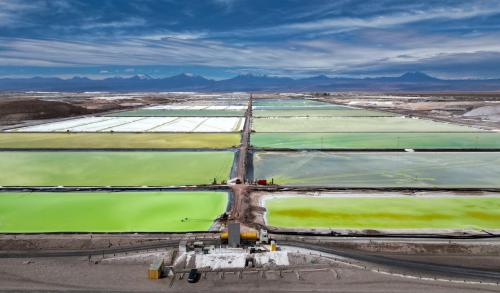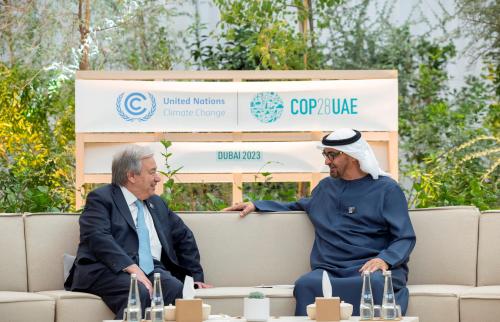Executive Summary
This report recommends ways to overcome obstacles to cooperation between the United States and China on climate change. The report is intended for senior leadership in each country, with the goal of helping them:
- understand relevant conditions in the other country
- appreciate the priorities and constraints of counterparts across the Pacific
- take action to control greenhouse gas emissions at home
- develop specific avenues of bilateral cooperation
- facilitate agreement in multilateral negotiations on these topics
Opportunities for collaboration in fighting climate change are plentiful, but moving forward at the scale needed will require high-level political support in two very different societies, each with considerable suspicion of the other. This report recommends ways to win such support and sustain it for the long term.
Chapter 1 of the report provides a primer on two topics: climate change and U.S.-China relations. It describes the climate change threat, concluding that every year of delay in responding to it puts both countries—and the planet—at greater risk. Because the United States and China are the world’s top two greenhouse gas emitters, together accounting for more than 40% of annual emissions, any solution requires both countries to transition to low-carbon economies. U.S.-China cooperation on climate change would have not only bilateral but global benefits.
In this connection, U.S.-China relations have evolved and grown enormously since the Nixon visit to Beijing in 1972. But despite this progress, underlying mutual distrust over long-term intentions has grown and can over time make mutual antagonism a self-fulfilling prophecy. U.S.-China relations should now advance to a new stage that has the two countries consult and cooperate to address the most critical global issues of the 21st century. Climate change and clean energy, along with the global economic crisis, offer turning points. Cooperation on climate change can help move U.S.-China relations to a new stage; failure to cooperate can introduce significant new tensions.
Chapter 2 describes the climate change policies and politics in each country. It explains that, in the United States, attention to climate change has exploded in the past five years. Many state and local governments, as well as U.S. companies, have taken significant action to address this issue. President Obama identifies energy policy and climate change as top priorities. Significant action by the federal government on climate change is likely in the years ahead.
In China, energy efficiency has received serious attention, with significant national goals reflected in the current Five-Year Plan as well as various laws and regulations. Growth in renewable energy is also an important objective of national leaders. These and other policies, taken mainly to promote economic growth, energy security and clean air in China’s cities, have significant benefits when it comes to cutting greenhouse gas emissions.
Chapter 3 offers nine recommendations to U.S. and Chinese leaders on ways to cooperatively fight climate change. The recommendations embody the principle that cooperation must serve the interests of both sides.
Recommendation #1: Acknowledge legitimacy of each other’s perspectives
- The U.S. and China bring very different perspectives to the climate issue, reflecting their different histories and circumstances
- Neither side is likely to abandon its perspective, but each can recognize the legitimacy of the other’s viewpoint and avoid making these differences barriers to pragmatic cooperation
- Handling different perspectives well bilaterally can help promote the success of multilateral climate change negotiations
Recommendation #2: Build a clean energy framework for cooperation
- “Clean energy”—a key component of addressing climate change—provides a more politically attractive framework for U.S.-China bilateral cooperation than does climate change per se
- Clean energy evokes fewer ideological differences and nests cooperation in better-established policy and bureaucratic communities
- A focus on clean energy can help highlight benefits in related areas, from economic growth and recovery to local air pollution reduction to national security
Recommendation #3: Highlight one or two major headline initiatives
- When it comes to cooperation on climate change, the U.S. and China should think big and aim high
- It is important to capture the public’s imagination
- Candidates for headline programs include efforts to electrify vehicle fleets, maximize the energy efficiency of buildings, launch pilot projects in carbon capture and storage, and/or bring together millions of volunteers from each country to work in a new “Clean Energy Corps”
Recommendation #4: Emphasize co-development of technology
- The U.S. and China have complementary strengths in technology development
- The U.S. and China should announce one or more major technology co-development projects
- Each side will need to help meet the concerns of the other on difficult issues including intellectual property protection, enforcement of contracts and concessional financing
Recommendation #5: Promote local-to-local cooperation
- Local initiatives in both countries are numerous, dynamic and creative
- National-level cooperation should include as a high priority specific measures to enhance the capacities for local programs in the two countries to link up
Recommendation #6: Promote capacity building
- The United States has technical capabilities in areas such as standards setting, regulation and law drafting, large-scale database management, and instrumentation that can contribute significantly to Beijing’s capacities to monitor and evaluate energy policy outcomes
- Currently, insufficient capacity in these areas is a serious impediment to achieving the desired outcomes from China’s national government initiatives
- Washington should assist in enhancing Beijing’s capacity to monitor and evaluate its energy policy outcomes
Recommendation #7: Seek common ground on the nature of future commitments
- This is one of the most challenging issues in multilateral climate change negotiations, typically dividing developing countries from industrialized countries
- U.S.-China bilateral discussions cannot resolve this issue, but agreement on approaches could help significantly to shape broader multilateral agreements to fight global warming
- U.S.-China dialogue on the nature of future greenhouse gas emissions commitments can thus help promote agreement on this topic in multilateral negotiations
Recommendation #8: Use and improve existing structures for cooperation
- Build on existing agreements and programs
- Create a new dialogue on climate change and clean energy to parallel the existing Strategic Economic Dialogue
- Form a “U.S.-China Clean Energy Partnership”
Recommendation #9: Highlight clean energy in a U.S.-China summit
- Hold a U.S.-China summit meeting as soon as it can be fully prepared
- Make cooperation on climate change and clean energy a key pillar of this summit
- Agreement between the senior leaderships is a critical step toward serious U.S.-China climate change and clean energy cooperation
- Have the declaration of a clean energy partnership and affirmation of shared deep concern about climate change mark the inauguration of a new stage in U.S.-China relations, one that promotes the capacity of both countries to consult and cooperate on the most critical issues on the changing global agenda of the 21st century
Chapter 4 summarizes much of the foregoing in the form of a memo to the presidents of both countries, highlighting the key points in the report as a whole. The memo identifies four principal obstacles to successful cooperation between the U.S. and China on climate change and clean energy:
- mutual distrust
- different expectations on technology
- different expectations on finance
- common expectations of high costs
The memo recommends six guiding principles to shape activities of senior leaders on these topics:
- Respect and work with each other’s concerns
- Think big
- Select several flagship projects
- Build for the long-term
- Do not start with efforts that require substantial new budgetary appropriations
- Focus on economic opportunity
Together, the U.S. and China can make important progress in fighting global warming by cooperatively promoting clean energy. This can become an important foundation for the U.S.-China bilateral relationship in the years ahead. Wise leaders working together can produce great benefits for their own countries and the world.




